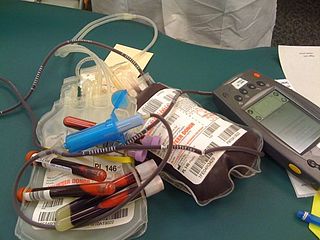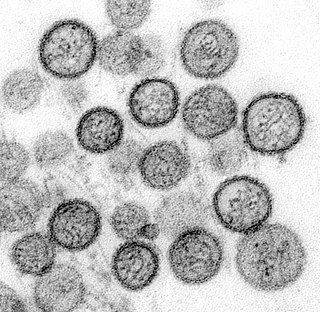Related Research Articles

Blood transfusion is the process of transferring blood products into a person's circulation intravenously. Transfusions are used for various medical conditions to replace lost components of the blood. Early transfusions used whole blood, but modern medical practice commonly uses only components of the blood, such as red blood cells, plasma, platelets, and other clotting factors. White blood cells are transfused only in very rare circumstances, since granulocyte transfusion has limited applications. Whole blood has come back into use in the trauma setting.

Whole blood (WB) is human blood from a standard blood donation. It is used in the treatment of massive bleeding, in exchange transfusion, and when people donate blood to themselves. One unit of whole blood increases hemoglobin levels by about 10 g/L. Cross matching is typically done before the blood is given. It is given by injection into a vein.

Babesiosis or piroplasmosis is a malaria-like parasitic disease caused by infection with a eukaryotic parasite in the order Piroplasmida, typically a Babesia or Theileria, in the phylum Apicomplexa. Human babesiosis transmission via tick bite is most common in the Northeastern and Midwestern United States and parts of Europe, and sporadic throughout the rest of the world. It occurs in warm weather. People can get infected with Babesia parasites by the bite of an infected tick, by getting a blood transfusion from an infected donor of blood products, or by congenital transmission . Ticks transmit the human strain of babesiosis, so it often presents with other tick-borne illnesses such as Lyme disease. After trypanosomes, Babesia is thought to be the second-most common blood parasite of mammals. They can have major adverse effects on the health of domestic animals in areas without severe winters. In cattle, the disease is known as Texas cattle fever or redwater.
Anti-thymocyte globulin (ATG) is an infusion of horse or rabbit-derived antibodies against human T cells and their precursors (thymocytes), which is used in the prevention and treatment of acute rejection in organ transplantation and therapy of aplastic anemia due to bone marrow insufficiency.

Hemolytic–uremic syndrome (HUS) is a group of blood disorders characterized by low red blood cells, acute kidney injury, and low platelets. Initial symptoms typically include bloody diarrhea, fever, vomiting, and weakness. Kidney problems and low platelets then occur as the diarrhea progresses. Children are more commonly affected, but most children recover without permanent damage to their health, although some children may have serious and sometimes life-threatening complications. Adults, especially the elderly, may show a more complicated presentation. Complications may include neurological problems and heart failure.

Carrion's disease is an infectious disease produced by Bartonella bacilliformis infection.
Rat-bite fever (RBF) is an acute, febrile human illness caused by bacteria transmitted by rodents, in most cases, which is passed from rodent to human by the rodent's urine or mucous secretions. Alternative names for rat-bite fever include streptobacillary fever, streptobacillosis, spirillary fever, bogger, and epidemic arthritic erythema. It is a rare disease spread by infected rodents and caused by two specific types of bacteria:
- Streptobacillus moniliformis, the only reported bacteria that causes RBF in North America
- Spirillum minus, common in Asia. Most cases occur in Japan, but specific strains of the disease are present in the United States, Europe, Australia, and Africa.

Oropouche fever is a tropical viral infection which can infect humans. It is transmitted by biting midges and mosquitoes, from a natural reservoir which includes sloths, non-human primates, and birds. The disease is named after the region where it was first discovered and isolated in 1955, by the Oropouche River in Trinidad and Tobago. Oropouche fever is caused by the Oropouche virus (OROV), of the Bunyavirales order of viruses.

A Jarisch–Herxheimer reaction is a sudden and typically transient reaction that may occur within 24 hours of being administered antibiotics for an infection by a spirochete, including syphilis, leptospirosis, Lyme disease, and relapsing fever. Signs and symptoms include fever, chills, shivers, feeling sick, headache, fast heart beat, low blood pressure, breathing fast, flushing of skin, muscle aches, and worsening of skin lesions. It may sometimes be mistaken as an allergy to the antibiotic.
Intraoperative blood salvage (IOS), also known as cell salvage, is a specific type of autologous blood transfusion. Specifically IOS is a medical procedure involving recovering blood lost during surgery and re-infusing it into the patient. It is a major form of autotransfusion.

Transfusion-related acute lung injury (TRALI) is the serious complication of transfusion of blood products that is characterized by the rapid onset of excess fluid in the lungs. It can cause dangerous drops in the supply of oxygen to body tissues. Although changes in transfusion practices have reduced the incidence of TRALI, it was the leading cause of transfusion-related deaths in the United States from fiscal year 2008 through fiscal year 2012.
An exchange transfusion is a blood transfusion in which the patient's blood or components of it are exchanged with other blood or blood products. The patient's blood is removed and replaced by donated blood or blood components. This exchange transfusion can be performed manually or using a machine (apheresis).
Type II hypersensitivity, in the Gell and Coombs classification of allergic reactions, is an antibody mediated process in which IgG and IgM antibodies are directed against antigens on cells or extracellular material. This subsequently leads to cell lysis, tissue damage or loss of function through mechanisms such as
- complement activation via the classical complement pathway
- Antibody-dependent cellular cytotoxicity or
- anti-receptor activity.

In transfusion medicine, transfusion-associated circulatory overload is a transfusion reaction resulting in signs or symptoms of excess fluid in the circulatory system (hypervolemia) within 12 hours after transfusion. The symptoms of TACO can include shortness of breath (dyspnea), low blood oxygen levels (hypoxemia), leg swelling, high blood pressure (hypertension), and a high heart rate (tachycardia).
An acute hemolytic transfusion reaction (AHTR), also called immediate hemolytic transfusion reaction, is a life-threatening reaction to receiving a blood transfusion. AHTRs occur within 24 hours of the transfusion and can be triggered by a few milliliters of blood. The reaction is triggered by host antibodies destroying donor red blood cells. AHTR typically occurs when there is an ABO blood group incompatibility, and is most severe when type A donor blood is given to a type O recipient.
This page is currently under construction.

Hantavirus hemorrhagic fever with renal syndrome (HFRS) is a group of clinically similar illnesses caused by species of hantaviruses. It is also known as Korean hemorrhagic fever and epidemic hemorrhagic fever. It is found in Europe, Asia, and Africa. The species that cause HFRS include Hantaan orthohantavirus, Dobrava-Belgrade orthohantavirus, Saaremaa virus, Seoul orthohantavirus, Puumala orthohantavirus and other orthohantaviruses. Of these species, Hantaan River virus and Dobrava-Belgrade virus cause the most severe form of the syndrome and have the highest morbidity rates. When caused by the Puumala virus, it is also called nephropathia epidemica. This infection is known as sorkfeber in Swedish, myyräkuume in Finnish, and musepest in Norwegian.
Serious Hazards of Transfusion (SHOT) is the United Kingdom's haemovigilance scheme.
Acute eosinophilic pneumonia (AEP) is an uncommon, acute-onset form of eosinophilic lung disease which varies in severity. Though poorly understood, the pathogenesis of AEP likely varies depending on the underlying cause which may include smoking, inhalation exposure, medication, and infection. In most patients, AEP is idiopathic, or has no known cause.
An allergic transfusion reaction is when a blood transfusion results in allergic reaction. It is among the most common transfusion reactions to occur. Reported rates depend on the degree of active surveillance versus passing reporting to the blood bank. Overall, they are estimated to complicate up to 3% of all transfusions. The incidence of allergic transfusion reactions is associated with the amount of plasma in the product. More than 90% of these reactions occur during transfusion.
References
- ↑ Heddle NM (November 1999). "Pathophysiology of febrile nonhemolytic transfusion reactions". Curr. Opin. Hematol. 6 (6): 420–6. doi:10.1097/00062752-199911000-00012. PMID 10546797.
- ↑ Sharma, RR; Marwaha, N (January 2010). "Leukoreduced blood components: Advantages and strategies for its implementation in developing countries". Asian Journal of Transfusion Science. 4 (1): 3–8. doi: 10.4103/0973-6247.59384 . PMC 2847337 . PMID 20376259.
- ↑ Addas-Carvalho M, Salles TS, Saad ST (June 2006). "The association of cytokine gene polymorphisms with febrile non-hemolytic transfusion reaction in multitransfused patients". Transfus Med. 16 (3): 184–91. doi:10.1111/j.1365-3148.2006.00665.x. PMID 16764597. S2CID 7005197.
- ↑ Yazer MH, Podlosky L, Clarke G, Nahirniak SM (January 2004). "The effect of prestorage WBC reduction on the rates of febrile nonhemolytic transfusion reactions to platelet concentrates and RBC". Transfusion. 44 (1): 10–5. doi:10.1046/j.0041-1132.2003.00518.x. PMID 14692961. S2CID 20755367.
- ↑ Le, Tao; Bhushan, Vikas; Sochat, Matthew; Vaidyanathan, Vaishnavi (3 January 2020). First Aid for the USMLE Step 1 2020: 30th Anniversary Edition (30th Anniversary ed.). McGraw Hill Education. p. 114. ISBN 978-1-26-046205-0.
- ↑ Kumar, Vinay; Abbas, Abul K.; Aster, Jon C., eds. (28 March 2017). Robbins Basic Pathology (Tenth ed.). Philadelphia, Pennsylvania: Elsevier. p. 491. ISBN 978-0-323-35317-5.
- 1 2 "Proposed standard definitions for surveillance of noninfectious adverse transfusion reactions" (PDF). www.isbtweb.org. Archived from the original (PDF) on 2020-11-28. Retrieved 2019-01-09.
- ↑ "NHSN | CDC". www.cdc.gov. 2017-12-29. Retrieved 2018-09-18.
- 1 2 3 4 Bolton-Maggs, PHB; Poles, D (2018). "The 2017 Annual SHOT Report" (PDF). SHOT.
- ↑ "Complications of Transfusion: Transfusion Medicine: Merck Manual Professional" . Retrieved 2009-02-09.